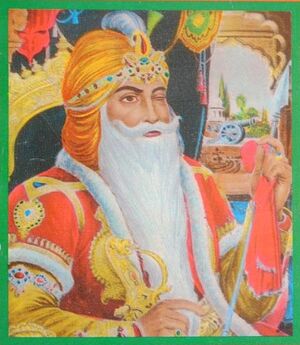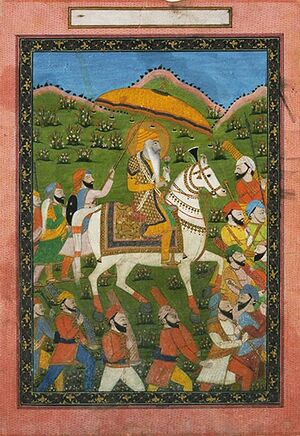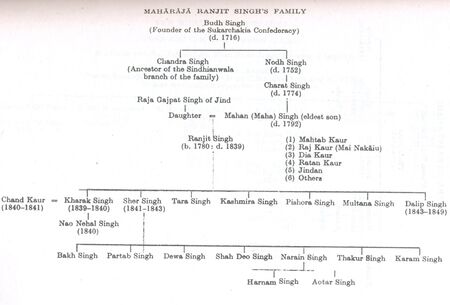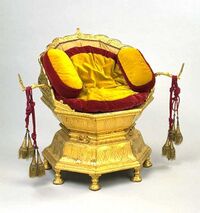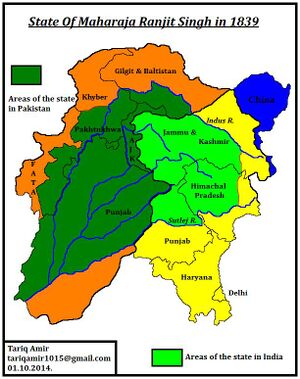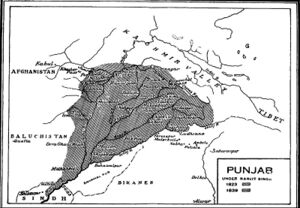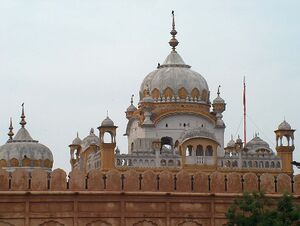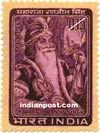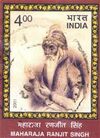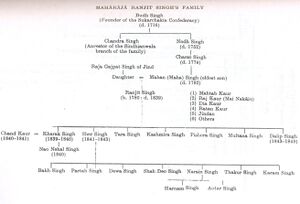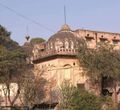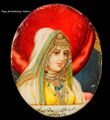Maharaja Ranjit Singh (Punjab)
Maharaja Ranjit Singh (Hindi:महाराजा रणजीतसिंह, Punjabi: ਮਹਾਰਾਜਾ ਰਣਜੀਤ ਸਿੰਘ), also called "Sher-e-Punjab" ("The Lion of the Punjab") (b.1780-27 June 1839) of Sandhawalia Jat Gotra, was a emperor of the Sovereignty country of Punjab and the Sikh Empire. His Samadhi is located in Lahore, Pakistan.
Contents
- 1 Early life
- 2 Maharaja
- 3 His Empire
- 4 Maharaja Ranjit Singh
- 5 Sikh temples built by Maharaja Ranjit Singh
- 6 Abolition of Capital Punishment
- 7 Character
- 8 Ranjit Singh's generals
- 9 Aftermath
- 10 Conquests
- 11 The Guru's Prophecy
- 12 Legacy
- 13 Postal Stamp
- 14 महाराजारणजीतसिंह संधुवालिया
- 15 महाराजा रणजीतसिंह द्वारा ठाकुर देशराज
- 16 पंजाब-केसरी महाराजा रणजीतसिंह
- 17 महाराज रणजीतसिंह की वंशावली
- 18 Gallery
- 19 References
- 20 Literature
- 21 External links
Early life
Maharaja Ranjit Singh was a Jat belonging to the Sikh faith born in 1780 in North India, Gujranwala, which is now located in modern day Pakistan; in a Jat Sikh[1][2][3] family of Sandhawalia Gotra.[4] At the time much of Punjab was ruled by the Jat Sikhs as well as Afghans, who had divided the territory among factions known as misls. Ranjit Singh's father Maha Singh was the commander of the Sukerchakia misl and controlled a territory in west Punjab based around his headquarters at Gujranwala.
Ranjit Singh succeeded his father at the young age of 12. After several campaigns, his rivals accepted him as their leader, and he united the Sikh factions into one state.
Maharaja
Ranjit Singh took the title of Maharaja on April 12, 1801 (to coincide with Baisakhi day). A descendant of Guru Nanak, the founder of the Sikh religion, conducted the coronation ceremony [5]. Lahore served as his capital from 1799. In 1802 he took the holy city of Amritsar.
He then spent the following years fighting the Afghans, driving them out of western Punjab. He also captured Pashtun territory including Peshawar. This was the first time that Pashtuns were ruled by non-Muslims. In a historical perspective, this event was very important. For more than a thousand years invaders had come down from the Khyber pass and ruled eastern lands. Ranjit Singh reversed this trend. When the Sikh empire finally fell to the English, they were able to retain this province. He captured the province of Multan which encompassed the southern parts of Punjab, Peshawar (1818), Jammu and Kashmir (1819) and the hill states north of Anandpur, the largest of which was Kangra.
Singh also hired European mercenaries to train his troops, creating the first modern Indian Army -- the Sikh Khalsa Army, a powerful military force whose presence delayed the eventual British colonization of Punjab. He created a powerful and heavily armed state; at this point, Punjab was the only state not controlled by the British. He brought law and order, yet never used the death penalty. He stopped Indian non-secular style practices by treating Hindus and Muslims equally. He banned the discriminatory "jizya" tax on Hindus and Sikhs.
The majority of Ranjit Singh's subjects were Muslim and had an intense loyalty towards him and his Sikhs. This was once highlighted when the foreign minister of the Sikh Empire, a Muslim named Fakir Azizuddin, had a meeting with the British Governor-General. When George Eden, 1st Earl of Auckland asked Fakir Azizuddin which of the Maharaja's eyes was missing, he replied: "the Maharaja is like the sun and sun has only one eye. The splendour and luminosity of his single eye is so much that I have never dared to look at his other eye." The Governor General was so pleased with the reply that he gave his golden wrist-watch to the Maharaja's Minister at Simla.
His Empire
His Empire was effectively secular as it did not discriminate against Sikhs, Muslims, Hindus or even atheists. It was relatively modern and had great respect for all religions and non-religious traditions of the Empire. The only main prominent religious symbols of the empire were the Maharaja and royal family being Sikh (but not Khalsa) and the Army being dominated by Sikh nobles and the Khalsa. The Maharaja never forced Sikhism on his subjects. This was in sharp contrast with the ethnic and religious cleansing of past Mughal rulers. Ranjit Singh had created a state based upon Sikh noble traditions, where everyone worked together, regardless of background, and where citizens were made to look at the things that they shared in common, e.g. being Punjabi, rather than any religious differences.
Ranjit Singh died in 1839.
Maharaja Ranjit Singh
Ram Sarup Joon[6] writes: Maharaja Ranjit Singh (Punjab) ascended the throne at the age of 11 years and his mother Raj Kaur looked after the administration during his minority. His father-in-Law Jai Singh who belonged to Kanhiyan Misal had also died. His Mother-in-law Sada Kaur proved to be a lady of great courage and sagacity. She used to put on a Man's robe and bear arms and became the leader of the troops of both the misals. Gradually they began to annex the territory belonging to other Misals and by the time Ranjit Singh grew up his territory had extended considerably.
In 1794 Shah Zaman, grand son of Ahmad Shah Durani attacked and occupied Lahore. He returned only because of the fear of an invasion by the Iranians and Lahore was reoccupied by the Sardars of the Bhangian Misal. Shah Zaman had left behind 12 heavy guns because of floods in the river Jhelum.
Ranjit Singh succeeded in taking 8 guns out of the river and sent them to Shah Zaman in Kabul. For this he was given the title of Raja and also the permission to occupy Lahore. First of all Ranjit Singh decided to subjugate two big Misals of Bhangian and Ramgarhian. Thereafter he succeeded in defeating all the other Misals and various Nawabs. The British who
History of the Jats, End of Page-187
by then become master of the greater part of India except the Punjab were very farsighted rulers. They immediately made friendship with Ranjit Singh and thus prevented his expansion towards the East. This agreement was made on 25th April 1809. Thereafter Raja Ranjit Singh spent all his life in fighting against the Pathans and making them acknowledge his supremacy. The Pathan women used to frighten their children by the name of Hari Singh Nalwa. Maharaja Ranjit Singh was devotee of Sadhus. He died June 1839.
His army included Hindus, Muslims and Sikhs. In administration he did not like any interference by the Jats. With this policy, he committed a big mistake. He appointed three Dogra Sardars Dhyan Singh, Gulab Singh and Suchet Singh, belonging to the same family as the sole administrators both in civil and military affairs. After the death of Ranjit Singh they were responsible for civil war amongst the Sikhs, but ultimately the Dogra Sardars carved out the kingdom of Jammu and Kashmir for themselves.
After the death of Maharaja Ranjit Singh his eldest son Kanwar Kharak Singh ascended the throne. He was not a capable man, but he did not permit his minister Dhyan Singh to do what he liked. At the age of 28, Kharak Singh was declared insane and then got murdered. It is said that he was murdered by Dhyan Singh. When they returned after cremating the body of Raja Kharak Singh, a door fell mysteriously on the head of Naunihal Singh and he died instantaneously. Thereafter, Dhayan Singh succeeded in convincing the Rani of Kharak Singk that the throne should not go to Sher Singh. It was announced that the Rani of Naunihal Singh was pregnant and Sher Singh's son Pratap Singh should not be considered the claimant to the throne. It was also decided that Sher Singh should retire to his jagir in Patiala. He accepted it gladly.
History of the Jats, End of Page-188
In the absence of Sher Singh, Sardar Saindha Walia and Dhyan Singh started conspiracies with the help of the British. Thereupon, Sher Singh decided to seize the throne forcibly. Rani Zidhan was killed by a maid servant. A year after this event Sardar Lahana Singh and Ajit Singh Sidhanwalia,who were cousins of Ranjit Singh, killed Sher Singh and Pratap Singh and placed Daleep Singh, the youngest son of Ranjit Singh, on the throne and put a Tilak on his forehead with the blood of their fingers. Daleep Singh's mother Rani Chand Kaur, became his guardian and Hira Singh, son of Dhyan Singh, became the minister. But he was killed by the Sikh Sardars. On hearing this news, an elder brother of Daleep Singh, named Pishora Singh declared himself an independent ruler in the fort of Attock. Mantri Jawahar Singh, grandson, of last Mantri Dhyan Singh, sent Sardar Chattur Singh Attariwala, and Tiwana Sardar Fateh Khan Motiyanwala against Pishora Singh but later they joined with Pishora Singh promising him the throne of Lahore. One night, however, they throttled him to death in his camp. Later on, these two Sardars were also killed by other Sikhs. Ultimately there was a revolt in the army of Daleep Singh and the soldiers demanded higher wages. His clever mother, Chand Kaur, thought it best to bring the army into conflict with the British and provoked them to invade British territory across the river Satluj and thus gain higher wages. At the same time she sent a letter to British Governor informing him how the rebel troops were marching against the British and warned them that if after conquering those forces they would try to occupy her territory across the river Satluj she would not be responsible for the consequences. In December 1845 there was a severe battle at Mudki between the British and the Sikh troops, in which the British came out victorious. The next battle at Firoz Shah was a draw. In 1846, Sir Henry Smith defeated the Sikhs at Aliwal. In 1847, there was another battle at Sobraon in which the Sikhs lost 8,000 soldiers and the British 2500. The Sikhs had to give
History of the Jats, End of Page-189
away their territory between the rivers Bias and Satluj, as war indemnity to the British.
Jammu and Kashmir was taken over by Gulab Singh in return for one crore of Rupees.
Thereafter, MoolRaj, Governor of Multan killed two British Officers.
Lord Lake marched against him with 74,000 troops and 40 guns. The Sikhs were supported by Mohammed Kabuli. In this war 24th Regiment of the British Army suffered heavy losses. Ultimately in the battle of Gujrat the Sikhs were defeated and the British occupied the Sikh kingdom.
Maharaja Daleep Singh was given a handsome pension and sent away to England, where he lived for the rest of his life.
Sikh temples built by Maharaja Ranjit Singh
At the Golden temple much of the present decorative gilding and marblework date from the early 1800s. All the gold and exquisite marble work were conducted under the patronage of Emperor Ranjit Singh, Maharaja of the Sikh Punjab. The Sher-e-Punjab Empire of the (Lion of the Punjab), was a heavy donor of wealth and materials for the shrine and is remembered with much affection by the Punjabi people. Maharaja Ranjit Singh also built two of the other most sacred temples in Sikhism. This was due to Maharaja Ranjit Singh having a deep love for the tenth Guru of Sikhism Guru Gobind Singh. The other two most sacred temples in Sikhism, which he built, are Takht Sri Patna Sahib (intiation or birth place of Guru Gobind Singh) and Takht Sri Hazur Sahib the place of Guru Gobind Singh's Sikh ascension into heaven.
Just like Maharaja Ranjit Singh has donated to have the Harmandir Sahib in Amritsar covered with gold leaf, he donated gold so that the roofs of Vishvanath temple in Banaras and Jwalamukhi and Kangra temples can be covered with gold leaf [7]. He had willed that the Kohinoor diamond be donated to the Jagannath Temple in Puri[8].
Abolition of Capital Punishment
Maharaja Ranjit Singh abolished capital punishment during his rule. [9]
Character
Maharaja Ranjit Singh once punished one of his Generals for killing a nightingale when she was warbling, which had annoyed the General[10]. Maharaja Ranjit Singh would help old men with their labour when he used to conduct his afternoon walks through Lahore, with his ministers. One incident was of an elderly man who could not lift a heavy sack. Maharaja Ranjit Singh asked the old man "Night is approaching, old man, why are you sitting here in darkness?". The elderly man answered that the sack is too heavy for me to carry home. The Maharaja carried the heavy sack all the way to the old man's house and was blessed by him[11].
Captain Murray's memoirs on Maharaja Ranjit Singh's character:
- "Ranjit Singh has been likened to Mehmet Ali and to Napoleon. There are some points in which he resembles both; but estimating his character with reference to his circumstances and positions, he is perhaps a more remarkable man than either. There was no ferocity in his disposition and he never punished a criminal with death even under circumstances of aggravated offence. Humanity indeed, or rather tenderness for life, was a trait in the character of Ranjit Singh. There is no instance of his having wantonly imbused his hand in blood." Murray (Captain), op.cit., p.174. [12][13].
List of Marriages of Maharaja Ranjit Singh :
Maharaja Ranjit Singh had 20 wives
The following were married by circumambulation :
1. Maharani Mehtab Kaur, daughter of Sada Kaur, born in 1783, married in 1786, muklawa in 1796, died in 1813. In 1807 she gave birth to twins, Maharaja Sher Singh and Tara Singh
2. Maharani Datar Kaur, (born Raj Kaur Nakai) daughter of Ran Singh Nakai, a Sandhu Jat married in 1797, died in 1838. Gave birth to Ranjit Singh's elder son and heir Maharaja Kharak Singh in 1801 and remained the Maharaja's favorite throughout his life.
3. Moran, a muslim dancing girl from Lahore, married in 1806, sent to live at Pathanfort in 1811.[14]
4. Rup Kaur, daughter of Jai Singh, headman of village Kot Said Mahmud in Amritsar district married in 1815.
5. Lacchmi, daughter of Desa Singh a Sandhu Jat of village Jogikikhan in Gujaranwala district, married in 1820.
6 & 7. Mahtab Devi & Raj Banso, daughters of Raja Sansar Chand Katoch of Kangra Kingdom, married in 1828, Raj Banso died in 1835 and Mahtab Devi become sati in 1839.
8. Gul Bahar or Gul Begum, a dancing girl of Amritsar, married in 1832, died at Lahore in 1863, received an allowance of 12,300 rs from the British government.
9. Ram Devi, daughter of Kaur Singh of village Chhachriwala in Gujaranwala district.
10. Bhuri Devi, who built a temple in Lahore.
11. Jind Kulan or Jind Bani, daughter of a Pathan from Mankera
The following were married by Chadardalna :
1. Rani Devi, daughter of Wazir Nakkuda of Jaswan in Una district of Himachal Pradesh.
2 & 3. Ratan Kaur and Daya Kaur, two sisters, widows of Sahib Singh of Gujrat. Ratan Kaur had a son named Multana Singh in 1819 while Daya Kaur had twins, Kashmira Singh and Pashaura Singh in 1821 named after the conquests of Multan, Kashmir and Peshawar.
4. Chand Kaur, daughter of Jai Singh Jat of Chainpur in Amritsar district, married in 1815, died in 1840.
5. Mahtab Kaur, daughter of Sujan Singh Jat of Gurdaspur district, married in 1822.
6. Saman Kaur, daughter of Suba Singh Jat of Malwa, married in 1832.
7. Gulab Kaur, daughter of a Jat zamindar of village Jagdev in Amritsar district.
8. Rani Jind Kaur, daughter of Manna Singh Aulakh Jat of village Chachar in Gujaranwala district. In 1835, she gave birth to Maharaja Duleep Singh
9. Har Devi, daughter of Chaudhary Ramu Rajput of Atalgarh.
10. Devno, of village Deval Vattala in Jammu territory. [15]
Ranjit Singh's generals
Ranjit Singh encircled himself with an array of generals and soldiers. They were men from different clans, castes and regions These included:
- Mahan Singh Mirpuri
- Hari Singh Nalwa
- Desa Singh Majithia
- Hukma Singh Chimni
- Dewan Mokham Chand
- Fateh Singh Ahluwalia
- Veer Singh Dillon later Jallaha of Gurdaspore
- Sawan Mal
- Sirdar Gulab Singh Pahuwindia
- Sham Singh Attariwala
- Sardar Sangat Singh Saini
- Sher Singh
- Shaikh Elahi Bakhsh
- General Ghause Khan (Mian Ghausa)
- Sultan Mahmud Khan (Son of Ghause Khan)
- Zorawar Singh
- Chattar Singh Attariwalla
- Balbhadra Kunwar – Gorkhali General who served for Ranjit Singh after the Anglo-Gorkha war (1814–1816).
- Mahan Singh Mirpuri
- Akali Phula Singh
- Lehna Singh Majithia
- Misr Diwan Chand
Among his European Mercenary Generals were:
- Jean-François Allard
- Jean-Baptiste Ventura – Italian (Modena)
- Paolo Di Avitabile – Italian (Naples)
- Claude August Court – French
Americans of note:
- Josiah Harlan – American general and later governor of Gujrat
- Alexander Gardner – American (Scots – Irish)
Aftermath
Maharaja Ranjit Singh died in 1839, after a reign of nearly forty years, leaving seven sons by different queens. He was cremated, his ceremony was performed by both Sikh and Hindu priests. His wife Maharani Mahtab Devi Sahiba, the Empress of Punjab, the Princess of Kangra, daughter of Maharaja Sansar Chand, committed Sati with Ranjit's body as Ranjit's head lay in her lap; some of the other wives also joined her and committed Sati.[16]
The throne went to his eldest son Kharak Singh and the empire began to crumble due to poor governance and political infighting among his heirs. The Sikh princes died through internal plots and assassinations, while the nobility struggled to maintain their power.[36]
Conquests
Ranjit Singh and his brave Sikh generals were capable of conquering such a great expanse of land for many reasons, varying from their Sikh discipline to their modern weaponry. Ranjit Singh's early conquests were minor and forgettable when he was a young misldar (baron). He conquered vast tracts of territory on all sides of his kingdom. And by 1799, he had captured Lahore.
From the capture of Lahore, he rapidly annexed the rest of the Punjab. The war rose to a climax at the battle of Multan. Thereafter he was the undisputed ruler of northern India and the land of the five rivers. And even then, to secure his empire, he defeated the Pashtun militias and tribes. The tables having been turned on the Mughals and Afghans, Ranjit Singh conquered yet more territory. In the year 1802, Ranjit Singh successfully invaded Kashmir.
The Guru's Prophecy
The tenth Guru of Sikhism had ordered his Sikhs not to build any monument of him.[17]. The place where Guru Gobind Singh, made ascension, and left the earth was Nanded in current Maharashtra in 1708. Anyone who did build any monument of him, would make his living male progeny and blood lineage die and extinct.[18] Maharaja Ranjit Singh was renowned for his love of the tenth Guru of Sikhism[19]. Scholars of the time record he often used to refer to himself as "Guru Gobind Singh's Drum". His love for the Guru would bring him into conflict with the prophecy; he defied it, and built one of the five holiest sights in Sikhism, a Gurdwara, Takht Sri Hazur Sahib[20]. Takht Sri Hazur Sahib was built as a monument and sacred place of worship to honour the place where Guru Gobind Singh left the earth and made ascension. It was completed in 1839 and that same year Maharajah Ranjit Singh died. All of his sons, except Dalip Singh, died within 5 years of his death and the temple's completion. His only remaining infant son Maharajah Dalip Singh was made kingdom less as a child by the British, within 10 years of Maharajah Ranjit Singh's death. He died penniless, in a hotel room in Paris, after spending most of his life trying to return to Punjab, his people and regain his lost Empire[21]. Much has been written about the ending of Maharaja Ranjit Singh's Empire, family and the Guru Prophecy. The most recent being a book written by English author Christy Campbell in his renowned book "The Maharajah's Box: An Imperial Story of Conspiracy, Love and a Guru's Prophecy"[22].
Legacy
Rulership of the state went to his eldest son Kharak Singh. Most historians believe competent political heirs would have forged a highly durable, independent and powerful state, as Ranjit Singh had done during his rule. However, the Kingdom began to crumble due to poor governance and political mismanagement by his heirs. His successors died through accidents and murder, while the nobility and army struggled for power.
After the First Anglo Sikh War, Punjab was defeated and all major decisions were made by the British Empire. The Khalsa Army was reduced, under the peace treaty with the British Empire, to a tiny skeleton force. Massive punishing war compensation destroyed any meaningful, independent fiscal policy. At the end of the Second Anglo Sikh War, it was annexed by the British from Ranjit Singh's youngest son Duleep Singh.
Ranjit is remembered for uniting the Punjab as a strong state and his possession of the Koh-i-noor diamond. Ranjit Singh willed the Koh-i-noor to Jagannath Temple in Orissa while on his deathbed in 1839. His most lasting legacy was the beautification of the Harmandir Sahib, holiest site of the Sikhs, with marble and gold, from which the popular name of the "Golden Temple" is derived.
He was also known as Sher-e-Punjab, the Lion of Punjab and is considered one of the 3 Lions of India, the most famous and revered heroes in North Indian history. While Emperor Maharaja Chola and Ashoka were the 2 most powerful Indian kings of history, they are not named among the 3 Lions. The other 2 Lions are Rana Pratap Singh of Mewar and Chhatrapati Shivaji, the legendary Maratha ruler. The title of Sher-e-Punjab is still widely used as a term of respect for a powerful man.
After his death, the British took his heir, the young prince Maharaja Duleep Singh, to England where he was put under the protection of the Crown. He was forced to convert to Christianity, before re-converting to Sikhism later in his life.
Postal Stamp
Indian Postal Department issued a commemorative stamp on him on 28/06/1966 of Denomination 0.15 .[23]
महाराजारणजीतसिंह संधुवालिया
महाराजा रणजीत सिंह का उपनाम शेर-ए-पंजाब था। महाराजा रणजीत सिंह का जन्म 13 नवंबर, 1780 गुंजारवाला ( पश्चिम पंजाब – वर्तमान समय में पाकिस्तान का हिस्सा) एक जाट परिवार में हुआ था। उनके पिता का नाम महा सिंह और माता का नाम राज कौर था। महाराजा रणजीत का विवाह 16 वर्ष की आयु में महतबा कौर से हुआ था। उन्होंने कई शादियाँ की, कुछ लोग मानते हैं कि उनकी 20 शादियाँ हुई थीं।उनकी मृत्यु सन 1839 हुई थी वो वर्तमान भारत पाकिस्तान से लेकर अफगानिस्तान तक जाट साम्राज्य के संस्थापक थे।
महाराजा रणजीत सिंह (Maharaja Ranjit Singh) का नाम भारतीय इतिहास के सुनहरे अक्षरों में लिखा गया है। पंजाब के इस महावीर नें अपने साहस और वीरता के दम पर कई भीषण युद्ध जीते थे। रणजीत सिंह के पिता सुकरचकिया मिसल के मुखिया थे। बचपन में रणजीत सिंह चेचक की बीमारी से ग्रस्त हो गये थे, उसी कारण उनकी बायीं आँख दृष्टिहीन हो गयी थी।महाराजा रणजीत सिंह नें लगभग 40 वर्ष शासन किया। अपने राज्य को उन्होने इस कदर शक्तिशाली और समृद्ध बनाया था कि उनके जीते जी किसी आक्रमणकारी सेना की उनके साम्राज्य की और आँख उठा नें की हिम्मत नहीं होती थी।
महा सिंह और राज कौर के पुत्र रणजीत सिंह दस साल की उम्र से ही घुड़सवारी, तलवारबाज़ी, एवं अन्य युद्ध कौशल में पारंगत हो गये। नन्ही उम्र में ही रणजीत सिंह अपने पिता महा सिंह के साथ अलग-अलग सैनिक अभियानों में जाने लगे थे। अपने पराक्रम से विरोधियों को धूल चटा देने वाले रणजीत सिंह पर 13 साल की कोमल आयु में प्राण घातक हमला हुआ था। हमला करने वाले हशमत खां को किशोर रणजीत सिंह नें खुद ही मौत की नींद सुला दिया। उनके राज में कभी किसी अपराधी को मृत्यु दंड नहीं दिया गया था। रणजीत सिंह बड़े ही उदारवादी राजा थे, किसी राज्य को जीत कर भी वह अपने शत्रु को बदले में कुछ ना कुछ जागीर दे दिया करते थे ताकि वह अपना जीवन निर्वाह कर सके।वो महाराजा रणजीत सिंह ही थे जिन्होंने हरमंदिर साहिब यानि गोल्डन टेम्पल का जीर्णोधार करवाया था।काशी के विश्वनाथ मंदिर में भी उन्होंने अकूत सोना अर्पित किया था। वो भारत के अंतिम राजा थे जिनके पास कोहिनूर हीरा था
पंजाब के भिन्न-भिन्न मिसलों पर जीत हासिल की
ई॰ 1803 में अकालगढ़ पर विजय।
ई॰ 1804 में डांग तथा कसूर पर विजय।
ई॰ 1805 में अमृतसर पर विजय।
ई॰ 1809 में गुजरात पर विजय।
महाराजा रणजीत सिंह नें किया सतलज पार के प्रदेशो को अपने आधीन
ई 1806 में दोलाधी गाँव पर किया कब्जा।
ई॰ 1806 में ही लुधियाना पर जीत हासिल की।
ई॰ 1807 में जीरा बदनी और नारायणगढ़ पर जीत हासिल की।
ई॰ 1807 में ही फिरोज़पुर पर विजय प्राप्त की।
अमृतसर की संधि
महाराज रणजीत सिंह के सैनिक अभियानों से डर कर सतलज पार बसी हुई सिख रियासतों ने अंग्रेजो से संरक्षण देने की प्रार्थना की थी ताकि वह सब बचे रह सकें| तभी उन रियासतों की प्रार्थना पर गर्वनर जनरल लार्ड मिन्टो ने सर चार्ल्स मेटकाफ को रणजीत सिंह से संधि करने हेतु उनके वहाँ भेजा था| पहले तो रणजीतसिंह संधि प्रस्ताव पर सहमत नही हुए परंतु जब लार्ड मिन्टो ने मेटकाफ के साथ आक्टरलोनी के नेतृत्व में एक विशाल सैनिक टुकड़ी भेजी और उन्होंने अंग्रेज़ सैनिक शक्ति की धमकी दी तब रणजीतसिंह को समय की मांग के आगे झुकना पड़ा था।
अंत में चातुर्यपूर्वक महाराजा रणजीत सिंह नें तारीख 25 अप्रैल 1809 ईस्वी के दिन अंग्रेजो से संधि कर ली। इतिहास में यह संधि अमृतसर की संधि कही जाती है।
कांगड़ा पर विजय (ई॰ 1809): अमरसिंह थापा नें ई॰ 1809 में कांगड़ा पर आक्रमण कर दिया था। उस समय वहाँ संसारचंद्र राजगद्दी पर थे। मुसीबत के समय उस वक्त संसारचंद्र नें रणजीतसिंह से मदद मांगी, तब उन्होने फौरन उनकी मदद के लिए एक विशाल सेना की रवाना कर दी, सिख सेना को सामने आता देख कर ही अमरसिंह थापा की हिम्मत जवाब दे गयी और वह सेना सहित उल्टे पाँव वहाँ से भाग निकले। इस प्रकार कांगड़ा राज्य पर भी रणजीत सिंह का आधिपत्य हो गया।
मुल्तान पर विजय (ई॰ 1818): उस समय मुल्तान के शासक मुजफ्फरखा थे उन्होने सिख सेना का वीरतापूर्ण सामना किया था पर अंत में उन्हें हार का सामना करना पड़ा था। महाराजा रणजीत सिंह की और से वह युद्ध मिश्र दीवानचंद और खड्गसिंह नें लड़ा था और मुल्तान पर विजय प्राप्त की थी। इस तरह महाराजा रणजीत सिंह नें ई॰ 1818 में मुल्तान को अपने आधीन कर लिया।
कटक राज्य पर विजय (ई॰ 1813): वर्ष 1813 में महाराजा रणजीत सिंह ने कूटनीति द्वारा काम लेते हुए कटक राज्य पर भी अधिकार कर लिया था | ऐसा कहा जाता है की उन्होंने कटक राज्य के गर्वनर जहादांद को एक लाख रूपये की राशि भेंट दे कर ई॰ 1813 में कटक पर अधिकार प्राप्त कर लिया था|
कश्मीर पर विजय (ई॰ 1819): महाराजा रणजीत सिंह नें 1819 ई. में मिश्र दीवानचंद के नेतृत्व मे विशाल सेना कश्मीर की और आक्रमण करने भेजी थी। उस समय कश्मीर में अफगान शासक जब्बार खां का आधिपत्य था। उन्होनें रणजीत सिंह की भेजी हुई सिख सेना का पुरज़ोर मुकाबला किया परन्तु उन्हे पराजय का स्वाद ही चखना पड़ा। अब कश्मीर पर भी रणजीत सिंह का पूर्ण अधिकार हो गया था।
डेराजात की विजय (ई॰ 1820-21): आगे बढ़ते हुए ई॰ 1820-21 में महाराजा रणजीत सिंह ने क्रमवार डेरागाजी खा, इस्माइलखा और बन्नू पर विजय हासिल कर के अपना अधिकार सिद्ध कर लिया था।
पेशावर की विजय (ई॰ 1823-24): पेशावर पर जीत हासिल करने हेतु ई॰ 1823. में महाराजा रणजीत सिंह ने वहाँ एक विशाल सेना भेज दी। उस समय सिक्खों ने वहाँ जहांगीर और नौशहरा की लड़ाइयो में पठानों को करारी हार दी और पेशावर राज्य पर जीत प्राप्त कर ली। महाराजा की अगवाई में ई॰ 1834 में पेशावर को पूर्ण सिक्ख साम्राज्य में सम्मलित कर लिया गया।
लद्दाख की विजय (ई॰ 1836): ई॰ 1836 में महाराजा रणजीत सिंह के सिक्ख सेनापति जोरावर सिंह ने लद्दाख पर आक्रमण किया और लद्दाखी सेना को हरा कर के लद्दाख पर आधिपत्य हासिल कर लिया|
महाराजा रणजीत सिंह की मृत्यु: भारतीय इतिहास में अपनी जगह बनाने वाले प्रचंड पराक्रमी महाराजा रणजीत सिंह 58 साल की उम्र में सन 1839 में मृत्यु को प्राप्त हुए। उन्होने अपने अंतिम साँसे लाहौर में ली थी। सदियों बाद भी आज उन्हे अपने साहस और पराक्रम के लिए याद किया जाता है। सब से पहली सिख खालसा सेना संगठित करने का श्रेय भी महाराजा रणजीत सिंह को जाता है। उनकी मृत्यु के पश्चात उनके पुत्र महराजा खड़क सिंह ने उनकी गद्द्दी संभाली।
महाराजा रणजीतसिंह द्वारा ठाकुर देशराज
ठाकुर देशराज [24] ने लिखा है ... महाराजा रणजीतसिंह - यह शशि खानदान के सिख जाट थे। सन 1830 ई. तक सारे पंजाब पर इन्होंने कब्जा कर लिया था। इन्हें पंजाब केसरी के नाम से याद किया जाता है। वास्तव में यह भारत के नेपोलियन थे। यदि भारत में अंग्रेज़ नहीं आए होते तो सारे भारत और अफगानिस्तान पर इनकी विजय पताका लहराई होती।
सन 1835 ई. में फ्रांस के बादशाह की ओर से तौहफ़े आए थे। इसी वर्ष जर्मनी से हांगवर्गर, अमेरिका से हारेंस, नेपाल से राजदूत किशनचंद और तिब्बत नरेश के
[पृ.167]: लघु भ्राता भीमकाल महाराज से मुलाकात करने के लिए आए थे। इससे उनके प्रताप का परिचय सहज ही मिल जाता है। उनके यहां की प्रसिद्ध वस्तुओं में कोहिनूर हीरा, लीली घोड़ी और जमजमा तोप सबसे बेशकीमती थे। कहा जाता है कि इरान का बादशाह घोड़ी के पहले मालिक यार मोहम्मद को 50 हजार नगद और 25 हजार की जागीर देना चाहता था। इनके अलावा |औरंगजेब और अहमद शाह बादशाहों के सिरपेंचों के हीरे भी उनके यहां थे।
उनके राज्य का भूमि कर (केवल छोटांश और दशांश से वसूल किया हुआ) जागीरों समेत ढाई करोड़ से ऊपर था। इसके अलावा 44 लाख प्रति वर्ष नमक करसे और एक करोड़ शालों के ठेके से आमदनी होती थी। सिक्का उनका अपना चलता था जिस पर 'तलवार का आदर' लिखा रहता था।
उनकी राजसभा का नाम गुरुमता यह उनका मंत्रिमंडल था। महाराज के पास जागीरदारों समेत 82 हजार से ऊपर सेना थी।
महाराज रणजीत सिंह नमूने के योद्धा विजेता और शासक थे। यह उन्हीं का बल था कि लगभग 800 वर्ष से चली आई पंजाब की मुसलमान सल्तनत को जड़ से उखाड़ कर फेंक दिया। और जिन पठानों का भारत पर लगातार विजय पाने से सिर आसमान पर चढ़ गया था, उन्हीं पठानों से भेंट, खिराज और नजराने लिए तथा उन्हीं की आबादी डेरागाजीखां, जमरूद,
[पृ.168]: और यूसुफजई में उन्हें परास्त करके अपनी हुकुमत कायम की। कश्मीर, कंधार, पेशावर और सतलज के बीच का कुल उनके राज्य में शामिल था। वास्तव में वे अपने समय के सर्वोच्च मुल्क शासक और यौद्धा थे।
पंजाब-केसरी महाराजा रणजीतसिंह
सिक्खों की 12 मिसलों की स्थापना सम्बन्धी वृत्तान्त पीछे लिखा जा चुका है। इन्हीं 12 मिसलों में सुकरचकिया एक जबरदस्त मिसल थी। महाराजा रणजीतसिंह इसी मिसल में पैदा हुए थे।
इस मिसल का नाम सुकरचकिया इसलिए पड़ा था कि इस मिसल के संस्थापक और सदस्य सुकरचकिया गांव के निवासी थे। सुकरचकिया जाट मिसल थी, क्योंकि इसका नेता सरदार चरतसिंह जाट था। इस मिसल का इतना बल बढ़ा कि आगे चलकर इस मिसल का नेता महासिंह अन्य मिसलों के संचालकों में प्रधान माना गया। सुकरचकिया या सकरचन्द मौजा अमृतसर के निकट था। सरदार चरतसिंह ने थोड़े ही दिनों में वह शक्ति प्राप्त की कि युद्ध के लिए हर समय उनके पास ढाई हजार सैनिक तैयार रहते थे। ज्ञात ऐसा होता है कि यह कुल सिन्ध के जाटों का था, क्योंकि सिन्धान वालिया कहलाने वाले और सुकरचकिया इन दोनों वंशों के पूर्वजों का निकास एक ही स्थान से था। इनके पूर्वज भी (दोनों के) एक ही थे।
चरतसिंह की पूर्वजों का जो वृत्तान्त हमें प्राप्त हो सका है, वह इस प्रकार से है - सन् 1470 ई० के लगभग पिण्डीभट्टियां नामक गांव में कालू नाम के एक जाट सरदार रहते थे।1 लड़ाकू मिजाज होने के कारण घर वालों से लड़कर बाहर निकल पड़े। अमृतसर के पास सांसेरी नामक गांव में डेरा जमाया। राजासांसी नाम का गांव भी इन्हीं का बसाया हुआ है। यहां पर कालूजी के एक लड़का हुआ जिसका नाम जादूवंशी था। किसी-किसी इतिहास-लेखक ने उसका नाम ईदूमान भी रखा है। सांसी गांव में रहने के कारण ये लोग आगे चलकर सांसी जाट नाम से पुकारे जाने लगे। दन्तकथा के आधार पर यह भी कहा जाता है कि - ‘कालूजी के बच्चे जीते न थे, इसलिए ज्योतिषियों ने उसे सलाह दी थी कि कि जन्मदिन में सबसे पहले आने वाले आदमी को बच्चा पालने को दे दिया जाए और बड़ा होने पर वापस ले लिया जाए, इस तरह करने से बच्चा दीर्घायु होगा। कालूजी ने ऐसा ही किया, परन्तु सबसे पहले आने वाला आदमी सांसी जाति का था। अतः सांसी द्वारा पालित होने के कारण उसके वंशधर सांसी कहलाये।’ यह दन्तकथा अधिक तथ्य नहीं रखती, क्योंकि सांसी जाटों का समूह पहले से ही मौजूद था जो कि चन्द्र के पर्यायवाची शब्द शशि से सांसी कहलाते थे। एक दूसरा सासानी नाम
1. यह स्थान लाहौर के दक्षिण पश्चिम में आबाद है।
जाट इतिहास:ठाकुर देशराज, पृष्ठान्त-237
का वंश Persia के उत्तर-पूर्व में बसा हुआ था, जिसके लिए ‘टाड साहब’ ने चन्द्रवंशी साबित किया है। सासानी शब्द, जिस प्रकार शशि से बना है, उसी प्रकार सांसी शब्द भी शशि से बना है।
कालूजी 1746 ई० में सांसी को छोड़कर वजीराबाद के पास सुण्ड में चले आए। यहां पर 1788 ई० में इनका स्वर्गवास हो गया। जादू वंशी ने सांसी जाटों का गिरोह बना करके लूट-मार आरम्भ कर दी, क्योंकि उस समय पंजाब में भारी अराजकता फैली हुई थी। किसी एक शासक का सारे पंजाब पर आधिपत्य न था। जो भी व्यक्ति शक्ति-संग्रह कर लेता था, वही किसी हिस्से का शासक बन बैठता। जाट कौम स्वभावतः या तो अराजकवादी थी या प्रजातन्त्रवादी। परन्तु परिस्थितियों ने उसे विवश कर दिया कि अनेक नौजवानों के हृदय में एकतन्त्र शासन या साम्राज्य कायम करने की भावनाएं जाग्रत हो उठीं । जादू भी ऐसे ही नौजवानों में से थे। राज्यवाद के विकास में एक स्थान डाके का भी है। प्रायः अनेक बड़े-बड़े राजा आरम्भ में डाकू की शक्ल में थे। जादू अपने साथियों समेत डाका डाल करके धन-संग्रह करता था और उस धन से साथियों की संख्या बढ़ाता था। सन् 1515 ई० के एक धावे में यह अपने अनेक साथियों के साथ मारे गए। जादू के मारे जाने के बाद उसका पुत्र गालिव सांसी जाटों का सरदार बन बैठा। गालिव के लिए मन्नू भी कहा जाता है। उसने बहुत सा धन और गाय-घोड़े संग्रह किये। लगभग तीस साल के अरसे में बहुत सा धन लूट-मार के जरिये से संग्रह कर लिया। सन् 1549 ई० में उसकी मृत्यु हो गई। उसकी मृत्यु के बाद उसका बेटा किद्दू सुण्डू गांव को छोड़कर गुजरांवाला के पास सुकरचकिया गांव में जाकर आबाद हो गया। यह बिल्कुल शान्त स्वभाव का लड़का था, इसलिए लोग इसको रामथल या भगतजी भी कहते थे। बाप के संग्रहीत धन से बहुत सी जमीन खरीदी और निष्कण्टक तथा निश्चिन्तता का जीवन व्यतीत करने लगा। अपने बाप की सी इसमें न उमंगें थीं, न ऊंचे इरादे। सन् 1578 में यह मर गया।
इसके दो लड़के थे - राजदाव और प्रेमू। बड़ा लड़का शान्त स्वभाव का था, उसने गुरुमुखी पढ़ करके व्यापार का काम आरम्भ कर दिया और उसका देहान्त 1620 ई० में हो गया। उसके तीन उत्तराधिकारी लड़कों में तेलू और नीलू तो युवावस्था में ही मर गए, लेकिन तीसरा बेटा तख्तमल अपने बाप के धन्धे-व्यापार द्वारा बड़ा भारी साहूकार बन गया। उसके दो बेटे थे - एक बाबू दूसरा बारा। बाबू ऐसे लोगों के दल में मिल गया जो लूट-मार के जरिये से मालामाल होना चाहते थे और साथ ही राज्य भी कायम करना चाहते थे। बारा गुजरांवाला के एक भगत का चेला बन गया और ग्रन्थ-साहब को पढ़कर सिक्ख-धर्म का प्रचार करने लग गया। सिक्ख-धर्म का वह इतना बड़ा प्रेमी था कि चलते, फिरते, उठते,
जाट इतिहास:ठाकुर देशराज, पृष्ठान्त-238
बैठते, खाते, पीते उसका प्रचार करता रहता था। सन् 1679 ई० में मरते समय अपने बेटे बुद्धा को सबसे पहले यह आज्ञा दी कि सिक्ख हो जाए और सिक्ख-धर्म का प्रचार करता रहे। बुद्धा ने अपने बाप का हुक्म मान करके सन् 1692 ई० में सिक्ख धर्म की दीक्षा ली। बुद्धा बड़ा बहादुर, साहसी और पराक्रमी था। सिक्खों के एक बड़े दल ने इसे अपना नेता मान लिया। वह इस दल के साथ लूट-मार करने लगा। अपनी दिलेरी और बहादुरी के प्रताप से उसने अपना बड़ा नाम पैदा किया और रहने के लिए एक विशाल भवन बनवाया। जैसा वह वीर था, वैसी ही उसके पास देसू नाम एक एक अवलख घोड़ी थी, जिस पर चढ़कर उसने पचासों बार झेलम, चिनाव और रावी नदियों को पार किया था। उसकी बहादुरी इसी से जानी जाती है कि उसके शरीर में तलवार और बरछों के चालीस घाव थे। जिधर से वह निकल जाता, लोगों में आतंक छा जाता था। सन् 1716 ई० में उसकी मृत्यु हो गई।
बुद्धासिंह की मृत्यु के बाद उसकी पतिव्रता और सत्यवती स्त्री ने कलेजे में तलवार भोंक कर जान दे दी, क्योंकि ऐसे बहादुर पति के वियोग को बर्दाश्त नहीं कर सकती थी। इस प्रकार वह अपने पति के साथ सती हो गई। बुद्धासिंह के दो बेटे नौधसिंह और चन्दासिंह नाम के थे। चन्दासिंह की औलाद के लोग सिंधिया वाले कहे जाते थे। दोनों लड़के अपने बाप के समान वीर थे। उन्होंने सुकरचकिया गांव को अपने अधिकार में कर लिया। नौधसिंह आक्रमण करने में इतना बहादुर था कि रावलपिण्डी से सतलज तक उसका खौफ छा गया था। मजीठ के सांसी जाट गुलाबसिंह ने अपनी लड़की की शादी नौधसिंह के साथ कर दी और गुलाबसिंह और उसका भाई नौधसिंह का साथ देने लगे।
अहमदशाह अब्दाली ने भारत पर जब पहला हमला किया था तो नौधसिंह ने नवाब कपूरसिंह के साथ मिलकर अब्दाली की सेना पर आक्रमण कर दिया और बहुत सा माल असबाब लूट लिया। इस लूट में उसके हाथ इतना माल लगा कि वह सुकरचक का सरदार कहलाने लगा। यह अहमदशाली अब्दाली वही था कि जिसने सन् 1761 ई० में पानीपत के मैदान में भारत की भाग्यश्री को समाप्त किया था। इस प्रकार से नौधसिंह महाराजा सूरजमलजी का समकालीन ठहरता है। नवाब कपूरसिंह सिक्खों में बहुत ही पूज्य थे। सिक्ख लोग उनको रिद्ध-सिद्ध सम्पन्न महापुरुष समझते थे। इनके साथ में सिक्खों का एक बड़ा भारी दल रहता था। राजा आलासिंह ने जो कि पटियाले के संस्थापक थे, अपने पुत्र लालसिंह तथा दौहित्र अमरसिंह जी को इन्हीं नवाब कपूरसिंह जी के हाथ से अमृत पिलवाकर सिक्ख-धर्म की दीक्षा दिलवाई थी। इस प्रकार से राजा आलासिंह जी भी महाराज सूरजमल तथा जवाहरसिंह के समकालीन थे।
जाट इतिहास:ठाकुर देशराज, पृष्ठान्त-239
सन् 1848 ई० (?) में अफगानों से युद्ध करते हुए नौधसिंह के गोली लगी। उसी की पीड़ा में उनका देहान्त हो गया। जिस समय नौधसिंह का देहान्त हुआ था उस समय उनके लड़के चरतसिंह की अवस्था केवल 5 साल की थी। सन् 1754 ई० के करीब उसने कुछ मजहबी सांसी जाट और दूसरे लुटेरों का गिरोह इकट्ठा करके लूटमार शुरू कर दी। उसने गुजरानवाला में एक मिट्टी का दुर्ग बना लिया और सिक्खों की एक मिसल बनाई। उसका इतना खौफ बढ़ा कि बकाली के सरदार मुहम्मदयार ने केवल डर की वजह से अपनी रियासत का इन्तजाम चरतसिंह के सुपुर्द कर दिया और खुद 15 सवारों के साथ उसके गिरोह में शामिल हो गया।1 चरतसिंह के पास आरम्भ में सिर्फ 150 सवार थे जिनकी मदद से उसने गुजरांवाला के किले पर कब्जा कर लिया और वहां के अमीरसिंह नामक एक सांसी सरदार की लड़की से शादी कर ली।2 अमीरसिंह भी इतना बहादुर था कि उसने झेलम से लेकर दिल्ली तक लूटमार की थी। उसके मुकाबले में खड़े होने की हिम्मत बहुत कम लोगों की पड़ती। इन दोनों सरदारों ने मिलकर के अमीनाबाद पर हमला किया और वहां के मुगल सरदार का कत्ल कर डाला। इनकी लूटमार और बहादुरी से लाहौर के सूबेदार को सशंक होना पड़ा। सन् 1757 में इनकी बढ़ती हुई ताकत को देखकर उसने इन पर हमला किया, परन्तु चरतसिंह और अमीरसिंह की मार के सामने मुसलमान ठहर न सके, वे भाग खड़े हुए और उनका बहुत-सा सामान चरतसिंह के हाथ लगा। इस लड़ाई में लाहौर के मुसलमान सरदारों को काफी नुकसान सहना पड़ा और उनको यह अनुभव हो गया कि हम चरतसिंह का मुकाबला नहीं कर सकते। बिना शक्ति, सहायता के इनसे विजय पाना असम्भव है।3
चरतसिंह जैसा बहादुर और पराक्रमी था, वैसा ही नीतिज्ञ और अग्रसोची भी था। उसने अपनी नीति से जस्सासिंह और भंगी सरदारों से मेलजोल पैदा कर लिया था। उसकी तीक्ष्ण बुद्धि का पता इस बात से चल जाता है कि अहमदशाह अब्दाली से, जबकि वह पानीपत लौटकर आ रहा था, टक्कर लेने की तैयारी से पहले ही उसने स्त्री-बच्ची और माल असबाब को जम्बू भेज दिया था।4 पानीपत के युद्ध में महाराज सूरजमल ने भी सदाशिवराव भाऊ को भी यही सलाह दी थी कि माल असबाब और स्त्री-बच्चों को किसी सुरक्षित स्थान में भेज दे। किन्तु भाऊ
1. तारीख पंजाब। पेज 384। भाई परमानन्द लिखित। 2. स्मरण रहे सांसी वंश था, गोत्र नहीं। 3. लाहौर के इस मुसलमान सरदार का नाम कि जिसका चरतसिंह से युद्ध हुआ था, ईदखां था। 4. तारीख पंजाब। पेज 384। भाई परमानन्द लिखित।
जाट इतिहास:ठाकुर देशराज, पृष्ठान्त-240
ने सूरजमल की सलाह को न माना और आखिरकार उसके उत्तराधिकारियों ने इसका फल भोगा। विचारणीय बात तो यह है कि जिस बात को ब्रज का जाट सोचता है, उसी को पंजाब का जाट भी सोच लेता है और भाऊ की भांति मूर्ख नहीं बनता। इसके सिवाय चरतसिंह ने एक बात यह और की कि अब्दाली के आने से पहले ही आस-पास के पठानों को लूट-पाट करके कमजोर बना दिया। अहमदशाह अब्दाली का दल बहुत था और पठान विजय के मद में चूर थे और वे हिन्दुस्तानी लोगों को गाजर-मूली की तरह समझते थे। उनका साहस बढ़ा हुआ था, फिर भी उनकी फौज पर छापा मार के उनको तंग कर ही दिया। अहमदशाह की फौज व्यास नदी को जब पार कर रही थी, तब जाट सिक्खों ने ऐसा हमला किया कि उनके होश उड़ गए। दोनों ओर से खूब लड़ाई हुई। अन्त में पठान भाग निकले। पठानों के भागने से कैदी हिन्दू लोग भी छूटकर सिखों का जय-जयकार मनाने लगे। अहमदशाह ने अपनी फौज के लोगों को बहुत तिरस्कृत किया कि वे जाटों के सामने से भाग खड़े हुए। अहमदशाह की यह भी इच्छा हुई कि कुछ दिन लाहौर में निवास करके सिखों का उचित प्रबन्ध किया जावे। परन्तु किसी कार्य विशेष से व्यग्र होकर उसको उसी काल में काबुल की ओर रवाना होना पड़ा।
वहां जाकर उसने एक नूरुद्दीन नामक सरदार को सात हजार फौज देकर सिखों के अत्याचार शान्त करने को भेज दिया।1 इधर इन दिनों में अब्दाली के चले जाने के बाद चरतसिंह ने वजीराबाद और अहमदाबाद को लूटकर अपने कब्जे में कर लिया। अहमदाबाद में उसे खबर मिली कि नूरुद्दीन हिन्दुओं को तंग कर रहा है तो झट वह उसके मुकाबले पर पहुंच गए।2 दोनों ओर से अत्यन्त साहस से लड़ाई हुई। अनेक वीर महानिद्रा में शयन कर गए। नूरुद्दीन पराजित होकर भाग निकला और स्यालकोट के किले में जा घुसा। जब सिखों ने स्यालकोट को भी घेर लिया तो वहां से रात्रि में भागकर जम्बू में जा पहुंचा।3 चरतसिंह ने नूरुद्दीन को लूटने के बाद चकवाल और पिण्डदादन खां को फतह किया और वहां के मुसलमानों से बहुत सा जुर्माना वसूल किया था। इन जगहों के मुसलमान चरतसिंह के सामने माफी मांगने को खड़े हुए तो उसने उदारतापूर्वक उनकी जान बक्स दी। इसके बाद साहब खां और राजाकाकोट नामक स्थानों को फतह करके गुजरानवाला वापस आया।4
1. इतिहास गुरु खालसा। पेज 593-94 2. तारीख पंजाब। पेज 385, भाई परमानन्द लिखित। 3. इतिहास गुरु खालसा, 594 4. तारीख पंजाब। पेज 385, भाई परमानन्द लिखित।
जाट इतिहास:ठाकुर देशराज, पृष्ठान्त-241
नूरुद्दीन के पराजित होने का समाचार लाहौर के सूबेदार ख्वाजा हमैयद खां ने सुना तो वह भी अपनी फौज लेकर के सिखों का मुकाबला करने के लिए निकल पड़ा। गुजरानवाला के समीप पहुंचकर भयानक युद्ध हुआ और यहां पर भी विजयलक्ष्मी सिखों के ही हाथ रही और हमैयद खां भाग्कर लाहौर चला गया। चरतसिंह की इन विजयों से उसका प्रभाव हिन्दू और मुसलमानों तथा सिख सभी पर छा गया।
इन दिनों जम्बू में रणजीत देव राज्य करता था, जिसका विस्तृत वर्णन ‘राजतरंगिणी’ में मिलता है। वह अपने बड़े बेटे ब्रजराज से अप्रसन्न था। उसको राज्य से वंचित रखकर अपने छोटे लड़के दयालुसिंह को राज्यगद्दी देना चाहता था। ब्रजराज ने विद्रोह का झण्डा खड़ा किया और चरतसिंह से मदद मांगी। अपने बाप को राज से अलग कर देने के बदले में बहुत सा रुपया बतौर सालाना खिराज के देने का वायदा भी चरतसिंह से किया। चरतसिंह की रणजीतदेव से पहले से ही शत्रुता थी क्योंकि हिन्दू राजा से युद्ध करने का यह पहला ही अवसर था। परिस्थियां मनुष्य को लाचार कर देती हैं। चरतसिंह मुसलमानी राज्य को उखाड़ कर पंजाब में जाटशाही कायम करने का इच्छुक था। इसके लिए उसे स्थाई सम्पत्ति और अधिक सेना की आवश्यकता थी। रणजीतदेव से लड़कर विजयी होने में उसकी यह समस्या हल होती थी। इसलिए उसने इस समय को अच्छा अवसर समझकर के जम्बू पर चढ़ाई कर दी। चाहिए तो यह था कि सभी सिख-जाट चरतसिंह की मदद करते। परन्तु भंगी नसल के जाट कुछ लोभ में आकर रणजीतदेव के साथ मिल गए। चरतसिंह की सहायता के लिए कन्हैया मिसल का सरदार जयसिंह भी साथ था। इन्होंने जम्बू राज की वसन्ती नामक नदी के किनारे अपनी सेना उतार दी। जब जम्बू नरेश को यह समाचार मिला तो उसने अपनी सहायता के लिए चम्बा, नुपुर, बूशहर और कांगड़ा के सरदारों से मदद मंगवाई क्योंकि वह जानता था कि चरतसिंह से मामना करना मेरी ताकत से बाहर है। जब उसकी मदद को वे लोग आ गए, तब उसने चरतसिंह का सामना उसी नदी के किनारे किया, जहां कि उसकी सेना पड़ी हुई थी। चरतसिंह लड़ाई लड़ने में खूब निपुण था। उसने कई ओर से रणजीतदेव की फौज पर आक्रमण किया। आक्रमण के समय छोटी-छोटी टोली सैनिकों की भेजता था। उसमें बहादुरी की एक खास बात यह भी थी कि वह इन फौजी टुकड़ियों के साथ खुद जाता था। चरतसिंह की जीत अवश्यम्भावी थी किन्तु उसकी तोड़ेदार बन्दूक फट जाने से उसकी मृत्यु हो गई और अपने ऊंचे विचार लेकर सदा के लिए दूसरी दुनिया को चला गया। मृत्यु के समय उसके बड़े लड़के महासिंह की अवस्था केवल 10 साल की थी।
महत्वाकांक्षी पुरुष अपने समाज के लिए आदर्श होते हैं। चरतसिंह भी ऐसे
जाट इतिहास:ठाकुर देशराज, पृष्ठान्त-242
महापुरुषों में से था जिसने अपनी जाति के सामने एक महान् आदर्श रखा, उसी आदर्श पर चलकर के आगे उसकी सन्तान ने इतनी उन्नति की कि उसका पोता पंजाब-केसरी के नाम से पुकारा जाने लगा। चरतसिंह ने अपने बेटे के लिए तीन लाख सालाना आय का इलाका छोड़ा था। यह सब कुछ उसने तलवार के बल से प्राप्त किया था। भंगी मिसल का सरदार झण्डासिंह जो कि रणजीतदेव के साथ मिल गया था, चरतसिंह की धर्मपत्नी और सरदार जैसिंह कन्हैया ने एक महतर के हाथ से उसे मरवा दिया। उसकी मृत्यु से झगड़ा मिट गया और सेनायें अपने-अपने देश को वापस लौट गईं। यह घटना सन् 1774 ई० की है।
चरतसिंह की मृत्यु के एक साल बाद महासिंह ने झींद के स्वामी राजा गजपतसिंह की भाग्यवती कन्या राजकुंवरि से विवाह किया। महासिंह बड़ी भारी बारात लेकर झींद में आए। फुलकिया मिसल के सारे सरदार इनकी अगवानी को आये थे। विवाह के भोज और आनन्द आदि के समय नाभा और झींद के बीच एक झगड़ा उत्पन्न हो गया। कारण यह था कि बरातियों ने चराई की भूमि से घास काट ली थी। नाभा के कार्यकर्ताओं ने इन पर आक्रमण कर दिया। झींद का राजा विवाह का अवसर देखकर चुप रहा। जब उसको अवकाश मिला तो उसने नाभा के राजा हमीरसिंह को पकड़कर उसके बहुत से इलाके दबा लिए।
महासिंह की नाबालिगी में उसके राज्य का कुल काम उसकी मां देशां ने संभाला। उसके कुछ सरदार बागी भी हुए परन्तु उनकी बगावत असफल रही। देशां ने कन्हैया सरदार के साथ मिलकर रसूल नगर पर हमला किया जहां कि छत्ता मुसलमान राज करते थे। उसके शासक का नाम पीर मुहम्मद था। इस युद्ध में महासिंह भी मौजूद था। यद्यपि उसकी उम्र केवल बारह साल की थी तो भी युद्ध के कला-कौशल में अपने बाप से भी बढ़ा-चढ़ा था। इस लड़ाई का कारण यह है कि भंगी सरदार झण्डासिंह ने अहमदशाह अब्दाली की सेना पर आक्रमण करके जमजमा नामक तोप को छीन लिया था और उसे पीरमुहम्मद के पास अमानत के रूप में रख दिया था। वह उस तोप को देने से इन्कारी हो गया क्योंकि तोप बढ़िया थी। जब महासिंह ने उसके इलाके पर आक्रमण करके लूटमार की तो पीरमुहम्मद ने सन्धि करने की प्रार्थना की। परन्तु महासिंह सहमत नहीं हुआ और उसने पीरमुहम्मद को मार दिया और उसके बेटों को तोपों के मुंह के साथ बांधकर उड़ा दिया। इस बात से उसकी कीर्ति बहुत बढ़ गई। महासिंह ने रसूल-नगर का नाम रामनगर और अलीपुर का नाम अकालगढ़ रख दिया। पीरमुहम्मद के कुल इलाके को अपने राज्य में मिला लिया।
जाट इतिहास:ठाकुर देशराज, पृष्ठान्त-243
इस घटना के दो वर्ष पश्चात् महासिंह1 के यहां रानी राजकौर के गर्भ से रणजीतसिंह का जन्म हुआ। महासिंह ने पुत्रोत्सव में बड़ी भारी खुशी मनाई। कई दिन तक भोज होते रहे। कहते हैं सारे सिखों को भोज दिया गया था और हजारों रुपये दान किये गये थे। कुछ वर्ष बाद बालक रणजीतसिंह के चेचक निकली। महासिंह ने बहुतेरे दान-पुण्य किये। ज्वालामुखी और कांगड़ा को तोहफे भेजे। बालक रणजीतसिंह की जान तो बच गई, किन्तु एक आंख जाती रही। मुंह पर चेचक के दाग भी हो गए क्योंकि चेचक रणजीतसिंह के बड़े जोर से निकली थी।
इन्हीं दिनों तैमूरशाह ने भारत पर आक्रमण किया। मुलतान और बहावलपुर पर भंगी सरदारों का राज्य था। तैमूरशाह की लड़ाई में वे विजय प्राप्त न कर सके और उन्होंने बहावलपुर तथा मुल्तान को छोड़ दिया। भंगी सरदारों को इतना कमजोर समझकर महासिंह ने उनके ईशाखेल और मूसाखेल स्थानों पर कब्जा कर लिया और झंग पर चढ़ाई कर दी। चूंकि भंगी सरदार आपसी झगड़ों में लगे हुए थे, इसलिये उन्होंने महासिंह का मुकाबला नहीं किया। महासिंह का साहस और भी बढ़ गया और उसने स्यालकोट के निकटस्थ कोटली स्थान पर भी कब्जा कर लिया। यह स्थान बन्दूक बनाने में बड़ा प्रसिद्ध था। यहां की बनाई हुई बन्दूकें उस समय में पंजाब में बढ़िया समझी जाती थीं। इस स्थान पर महासिंह ने आस-पास के कई छोटे-छोटे सरदारों को मंत्रणा करने के बहाने से बुला लिया और कैद कर लिया। कहा जाता है कि उन पर बड़े जुर्माने किये और जुर्माने की रकम वसूल हो जाने पर उन्हें छोड़ा।
इतने में खबर लगी कि जम्बू का राजा ब्रजराज व्यभिचार में फंसकर प्रजा की गाड़ी कमाई को स्वाहा कर रहा है और उसकी प्रजा भी उससे तंग आ रही है। राज-काज की ओर से वह इतना लापरवाह है कि भंगी सरदारों ने उसका बहुत इलाका छीन लिया है। इस खबर से महासिंह की इच्छा हुई कि जम्बू पर कब्जा करने का यह दैवी मौका है। उधर व्रजराज सोच रहा था कि महासिंह से सहायता लेकर अपने छिने हुए इलाकों को वापस ले लेना कोई कठिन काम नहीं है। इसलिये उसने महासिंह से मदद मांगी। महासिंह ने पहली मित्रता का ख्याल करके व्रजराज को मदद दी भी, किन्तु कन्हैया मिसल के सरदार हकीकतसिंह से विजय प्राप्त नहीं हुई। इस तरह व्रजराज को दुहरा घाटा उठाना पड़ा। उसने जुर्माने के स्वरूप कन्हैया सरदार को पचास हजार सालाना दे करके जान बचाई। जब व्रजराज कायदे के अनुसार अदायगी न कर सका तो कन्हैया सरदार ने महासिंह को समझा-बुझाकर अपने साथ मिल जाने पर राजी किया। शर्त यह रखी
1. महासिंह का एक भाई भी था जिसका नाम सोहिजसिंह था। ‘पंजाब-केसरी’पेज 13
जाट इतिहास:ठाकुर देशराज, पृष्ठान्त-244
गई कि जम्बू राज्य को दोनों आधा-आधा बांट लें। महासिंह राजी हो गया और बहुत सी फौज लेकर जम्बू पर चढ़ गया। किन्तु कन्हैया सरदार से पहले पहुंच जाने के कारण उसने बिना उसके आये ही जम्बू पर धावा बोल दिया। व्रजराज में यह शक्ति न थी कि वह महासिंह का सामना कर सके, इसलिये वह भाग गया। महासिंह ने जम्बू शहर की बड़ी भारी लूट करवाई और अपने देश को बहुत से लूट का धन देकर चल दिया। कन्हैया सरदार ने महासिंह के इस काम को दगावाजी समझा। वह बहुत नाराज हुआ। इसी नाराजगी और चिन्ता में थोड़े ही दिनों में उसका देहान्त हो गया।
सन् 1784 ई०' में दीवाली के मौके पर महासिंह अमृतसर में स्नान को गया। यहां उसे कन्हैया मिसल के सरदार हकीकतसिंह का लड़का जैसिंह मिला। वह महासिंह से इस बात से बहुत नाराज था कि उसने उसके बाप हकीकतसिंह के साथ धोखा करके अकेले ही अकेले जम्बू को लूट लिया। इसी कारण से उसने महासिंह के बहुत से इलाके को अपने काबू में कर लिया था। महासिंह ने अमृतसर की इस मुलाकात में जैसिंह से मित्रता करने के लिये बहुत कुछ खुशामद की। परन्तु जैसिंह ने बिना जम्बू की लूट में से हिस्सा लिये मित्रता करना स्वीकार नहीं किया। महासिंह लूट में से हिस्सा नहीं देना चाहता था, इस कारण दोनों ओर से तनातनी हो गई और जैसिंह ने यहां तक कह दिया कि भगतिया (नाचने वाले लड़के) यहां से चले जाओ। महासिंह इसे बर्दाश्त न कर सका और कुछ सवार लेकर अमृतसर से बाहर निकल आया। कन्हैया सरदार ने जैसिंह से इस बात का बदला लेने के लिये और उसे नीचा दिखाने के लिये जस्सासिंह रामगढ़िया और राजा संसारसिंह कांगड़े वाले को गांठा। जस्सासिंह की कन्हैया सरदार से पहले लड़ाई हो चुकी थी और वह भागकर हांसी पहुंच गया था। उसने बड़ी प्रसन्नता के साथ महासिंह की सहायता करना स्वीकार किया। अन्य सरदार जो जैसिंह से अप्रसन्न थे, महासिंह के झण्डे के नीचे आ गये।
जैसिंह के निवास-स्थान बटाले में दोनों तरफ से बड़ी भारी लड़ाई हुई जिसमें कन्हैया सरदारों को बुरी तरह से हारना पड़ा। जैसिंह का पुत्र गुरुबख्ससिंह मारा गया। जैसिंह ने बाकी फौज लेकर नौशहरा में महासिंह पर फिर हमला किया परन्तु इस बार भी हारना पड़ा और भागकर नूरपुर पहुंचा। सन्धि का जब प्रस्ताव हुआ तो कांगड़े का दुर्ग संसारसिंह को और जस्सासिंह रामगढ़िये का कुल इलाका जो कि जैसिंह ने छीन लिया था, फेर देने की शर्त महासिंह की ओर से रखी गई। इस मौके पर गुरुबख्ससिंह की स्त्री सदाकौर ने बड़ी समझदारी से काम लिया कि अपनी बेटी महताबकौर की सगाई रणजीतसिंह के साथ करके दोनों मिसलों में मेल करा दिया। यह शादी आगे चल करके सन् 1786 ई० में बड़ी धूमधाम से बटाले में हुई। सन् 1788 ई० में भंगी सरदार गूजरसिंह का स्वर्गवास हो गया।
जाट इतिहास:ठाकुर देशराज, पृष्ठान्त-245
उसके दो बेटे फतहसिंह और साहबसिंह थे। इन दोनों में राज्य के लिये आपस में झगड़ा हो गया। महासिंह ने साहबसिंह से खिराज मांगा लेकिन साहबसिंह बहुत नाराज हो गया और उसने उनके इलाके गुजरात पर हमला कर दिया। साहबसिंह ने सहोदरा के किले में बैठ करके युद्ध किया। तीन महीने तक बराबर महासिंह सहोदरा का घेरा डाले पड़ा रहा, परन्तु बीमार होने के कारण उसे अपने स्थान गुजरानवाला में आना पड़ा और वह वहां आकर के मर गया।
‘तारीख पंजाब’के लेखक भाई परमानन्द ने लिखा है कि चरतसिंह और महासिंह दोनों बड़े वीर और विजयी हुये। उनके समय में सुकरचकिया मिसल का दबदबा बढ़ता ही गया और वह सब मिसलों में बड़ी मानी जाने लगी। खेद है कि इन दोनों महावीरों की स्त्रियां अच्छे चलन की न थीं।
और अधिक जानकारी के लिए पढ़िये-
- Jat History Thakur Deshraj/Chapter VII Part I (i) (246-299)
- Jat History Thakur Deshraj/Chapter VII Part I (ii) (299-400)
महाराज रणजीतसिंह की वंशावली
जौनधर (भटिंडा का राजा) → सधवा → सहस्य → लखनपाल → धरी → उदयरथ → उदारथ → जायी → पातु → डगर → करुत (कीर्ति) → वीरा → बध्या → कालू → जोंधोगन → वीतू या सट्टू → राजदेव → वाप्ता → प्यारा → बुद्धा (d.1716) → विद्धा (विधसिंह)/नौध (d.1752) → चरतसिंह (d.1774) → महासिंह (d.1792) → रणजीतसिंह (b.1780-d.1839) →1
1. यह वंश-वृक्ष हमने पंजाब केसरी (ले० नन्दकुमार देव शर्मा) से उद्धृत किया है। पे० परि० (ग पे०) 249-251 ।
इतिहास गुरुखालसा में लिखा है कि महाराज शालिवाहन ने स्यालकोट में राज्य स्थापित किया था। वि० सं० 135 में इसने विक्रमाजीत राजा को देहली में परास्त करके उसका सिर काट था। दिल्ली ही में इसने शक संवत् चलाया था। राजा विक्रम 300 वर्ष जीवित रहे थे, ऐसा कहा जाता है। एक इतिहास में शालिवाहन यदुवंशी था जो कि गजनी से लौट कर आया था, ऐसा लिखा है। एक शालिवाहन दक्षिण के शातिवाहनों में भी था, किन्तु यह शालिवाहन यदुवंशी ही जान पड़ता है। इसी के वंश में पूर्णभक्त और रसालु हुए हैं ।
जाट इतिहास:ठाकुर देशराज, पृष्ठान्त-302
- खड़गसिंह (d.1840) → नौनिहालसिंह (1840)
- शेरसिंह → बखसिंह + परताबसिंह + देवासिंह + शहदेवसिंह + नारायणसिंह + ठाकुरसिंह + करमसिंह
- दिलीपसिंह → विक्टर
Gallery
Samadhs (Tombs) of Maharani Raj Kaur ( Datar Kaur) wife of Bhatti Jat ruler Maharaja Ranjit Singh of Lahore and Mother of Maharaja Khadak Singh of Lahore. Maharani Datar Kaur was Daughter of Sardar Ran Singh, a Sandhu Jat of Nakai Misl. Rani Chand Kaur, wife of Maharaja Kharak Singh (Maharani Chand Kaur was daughter of Sardar Jaimal Singh, a Sandhu Jat of Kanhaiya Misl) and Ghulab Kaur, 2nd wife of Prince Naunihal Singh. These structures are located in Govt College, Civil Lines, Lahore. Source - Jat Kshatriya Culture
Star of the Prosperity of the Punjab (Kaukab-i-Iqbal-i-Punjab) Instituted by Sandhawalia Jat Ruler Maharaja Ranjit Singh of Lahore, Lion of Punjab in 1837. inspired by medals and awards worn by visiting Europeans at the court of Maharaja Ranjit Singh of Lahore in the 1830s. Source - Jat Kshatriya Culture with Damandeep Singh Sandhanwalia
Maharani Mehtab Kaur (1782-1813) Daughter of Sandhu Jat Ruler Raja Gurbakesh Singh Kahaniya and the first wife of Sandhawalia Jat Maharaja Ranjit Singh, Gouache. Heightened with gold on ivory by Rattan Singh, Punjab or Delhi. Circa 1810–30. © Toor Collection. She became Maharaja Ranjit Singh's first wife in 1796 in a marriage arranged by her mother, Maharani Sada Kaur, a powerful military leader. Mahtab Kaur's son, Sher Singh, went on to sit on the throne at Lahore. Source - Jat Kshatriya Culture
References
- ↑ The History Files. "Kingdoms of South Asia - Indian Kingdom of the Jats". The History Files. Retrieved 2012-10-21.
- ↑ The History Files. "Kingdoms of South Asia - Indian Kingdom of the Jat Sikhs". The History Files. Retrieved 2012-10-21.
- ↑ The History Files. "Kingdoms of South Asia - Indian Kingdom of Sikhs". The History Files. Retrieved 2012-10-21.
- ↑ H. S. Duleh: History of the Jatt Clans (Translation from original Punjabi work "Jattan da Itihas" by Gurjant Singh).
- ↑ http://www.sikhcybermuseum.org.uk/People/ranjitmaharaja.htm
- ↑ History of the Jats/Chapter XI,p.187-190
- ↑ Islamic Perspective by Ashgar Ali Engineer, Institute of Islamic Studies (Bombay, India) 1984
- ↑ Maharaja Ranjit Singh: The Last to Lay Arms By Kartar Singh Duggal, Published 2001 but now the kohinoor is took by the british maharja ranjit singh didnt lose his empire altogether he kept the british away from punjab and to this day punjab is a successful state Abhinav Publications
- ↑ http://www.jamboree.freedom-in-education.co.uk/real_history/maharaja.htm
- ↑ http://www.allaboutsikhs.com/articles/the-sikh-rule-and-ranjit-singh.html
- ↑ http://www.sikhcybermuseum.org.uk/People/ranjitmaharaja.htm
- ↑ Murray (Captain); History of The Punjab, Vol. II (Reprint, Patiala 1970)
- ↑ http://www.allaboutsikhs.com/articles/the-sikh-rule-and-ranjit-singh.html
- ↑ The Sikh Review Volume 46
- ↑ Dr. Sukhbir Singh Kapoor; The Sikh Religion and The Sikh People
- ↑ The Real Ranjit Singh; by Fakir Syed Waheeduddin, published by Punjabi University, ISBN 81-7380-778-7, 1 Jan 2001, 2nd ed.
- ↑ The Maharajah's Box, By Christy Campbell. (ISBN 0006530788)
- ↑ [1]
- ↑ The Maharajah's Box, By Christy Campbell. (ISBN 0006530788)
- ↑ The Maharajah's Box, By Christy Campbell. (ISBN 0006530788)
- ↑ The Maharajah's Box, By Christy Campbell. (ISBN 0006530788)
- ↑ [2]
- ↑ Postal Stamp on Maharaja Ranjit Singh
- ↑ Thakur Deshraj: Jat Itihas (Utpatti Aur Gaurav Khand)/Parishisht,p.166-166
Literature
- Maharaja Ranjit Singh, Lord of the Five Rivers, By Jean-Marie Lafont. (Oxford University Press. Date:2002, ISBN 0195661117).
External links
Back to The Rulers
